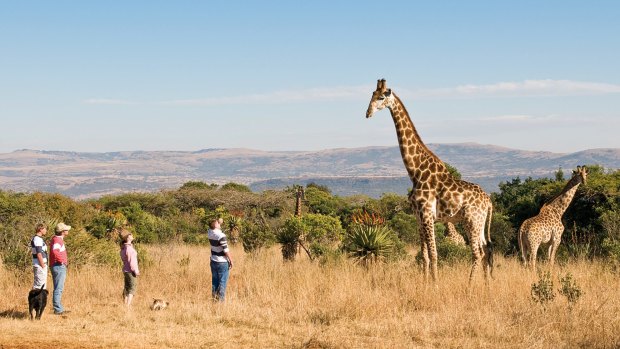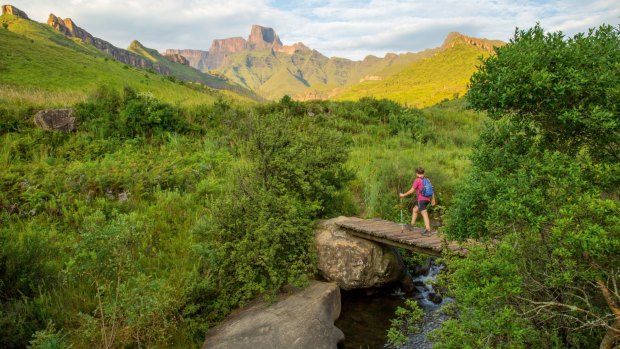This was published 4 years ago
South Africa, KwaZulu Natal: The best things to do in South Africa

Fugitives Drift game reserve.Credit: Fugitives Drift
Two hours' walk from the safety of our jeep in South Africa's oldest game reserve, Hluhluwe-iMfolozi Park, we kneel on the ground to talk about death and the afterlife.
It was very likely the last thing our walking party wanted to consider that beautiful dawn. We had left our jeep after a group hug to wish each other the best. My heart thumped with fear, but I felt slightly smug to be among the only three people from our Zulu-run Rhino Ridge Lodge brave enough to go off road and on foot to see wildlife up close.
Only 30 metres away a white rhino, with her baby nearby, sniffs the air suspiciously. Rhinos have poor eyesight and rely on their hearing and sense of smell.

Drakensberg, South Africa.Credit: Samantha Reinders
Putting aside the rifle, the only thing likely to stop the rhino if she smells danger, our Zulu guide Sbonelo Shabala kneels down to show us a symbolic native plant. Buffalo thorn is used to drag the spirit of a dead person to the afterlife. Zulus believe that if Shabala were to die there, his spirit would remain even after his corpse was removed. Thus, Shabala's family would carry a buffalo thorn branch to hook his soul and drag it home.
If the family travelled by bus, they would need to reserve a seat for his spirit. "If they stopped at McDonald's on the way home, my spirit would get its own seat at the table," Shabala says. The Zulu believe the thorns, that point upwards and forward, tell us that we should always look ahead to the future. The ones that point backwards remind us to never forget where we come from, Shabala adds.
A visit to South Africa is like that: Always looking to the thorny past to explain what is happening now.
When we lift our heads to resume walking, a "presentation" of wild animals appears on a nearby ridge looking as if a film director had called "action" on a scene. A mother rhino and her calf graze a few metres from a zebra nursing her baby while warthogs zip around like lunatics.
Shabala urges us to huddle together and stay still. "If you are calm, they are calm." Easier said than done. He doesn't fear the rhinos. He fears for them. His community now runs Rhino Ridge Lodge in a partnership, and he grew up on the land nearby and spent years defending rhinos from poachers.
The previous morning we were stopped in a game park traffic jam for 20 minutes when our vehicle was book-ended by two mature elephants. Later, two giraffes went neck-to-neck nearby in perfect rhythm for 15 minutes, swaying back and forth in an exercise designed to establish who's the boss, like sweet twins toying with the idea of adulthood.
On a game drive at another park, Nambiti Big Five Game Reserve, outside the town of Ladysmith, we screech with fright when something the "size of a huge plane" swoops within touching distance of our jeep. It is a lappet-faced vulture whose wingspan of up to three metres was wider than our vehicle. It stops in a tree nearby. Through binoculars, it is the most gorgeous ugly animal you are likely to see.
Some people go to South Africa to see the Big Five: lion, leopard, rhinoceros, elephant and Cape buffalo. Others go to see the Little Five: the elephant shrew, ant lion, rhinoceros beetle, buffalo weaver and leopard tortoise.
Yet a desperate desire to tick a lion off your bucket list – which turns educated guides into "jeep jockeys" – may mean missing out on what's right in front of you. This includes magnificent birds such as South Africa's Cape weavers which transfix this writer. The female bird trashes any woven upside-down nest (made by the male of the species) if she deems it unworthy. At Nambiti, we stop to admire a trapdoor spider's perfectly-round nest, then a trail left by frogs next to those of a leopard, and later attempt to hold our collective breaths when a rhino walks very slowly within a metre of our stationary vehicle.
Stopping to show us the difference between black and white rhino poo in Hluhluwe Imfolozi Reserve, Shabala describes the midden as "Facebook for rhinos" – it lets them know who's hot (on heat) and who's not.
A week in South Africa's KwaZulu Natal, the country's south-eastern province, is to walk in the footsteps of the Zulus, a deeply spiritual people and understand the history, its flora and fauna.
A visit to Isandlwana for a tour of the Zulu battlefields explains a lot. It was here on one very long day – January 22, 1879 – that the first major clash in the Anglo-Zulu war occurred. The British Empire's attempt to invade Zululand resulted in what many call the most humiliating defeat in British history. Later that day, and into the next, another battle at Rorke's Drift turned the tables.
At Isandlwana, located about halfway between the two game parks, British commander Lord Chelmsford had contemptuously underestimated the might of the 20,000 Zulu warriors armed only with assegai (spears) and shields, and a few wielding muskets. Using traditional Zulu battle techniques, the warriors surrounded the British troops within the "horns of the buffalo". It was featured in the 1964 Charlton Heston and Michael Caine film Zulu which still draws older tourists from the UK and elsewhere to the site.
On the afternoon of January 22 at a separate battle at nearby Rorke's Drift, the Zulus underestimated the British. A garrison of more than British 100 soldiers, many injured who had been hospitalised there, held their ground against 3000 Zulus for 12 hours.
Depending on who you read, they defeated them in honour. Eleven Victoria Crosses were awarded to those who defended Rorke's Drift. More recent reports claimed, controversially, that this victory turned into a crime scene, when the Brits slaughtered injured Zulus.
Fugitive's Drift Lodge, named for another battle nearby, runs tours that run nearly as long as the battle. The morning's four-hour guided tour of the vast valley where the battle of Isandlwana took place is conducted by a local guide, a descendant of one of the warriors who fought that day. Under the shade of a tree, sitting in fold-up chairs, looking out across the huge valley marked with communal graves, his soliloquy is punctuated by typical clicks of the throat made in Zulu.
Later that afternoon after a big lunch at the Lodge, the tour resumes to tell the battle of Rorke's Drift that started the same day and finished the next, January 23. This time it is told from the British perspective by Douglas Rattray, the son of a famous South African storyteller, who describes how a motley injured group of soldiers rallied to defeat the Zulus.
As the audience sits, wrapped in blankets with the sun fading, Rattray delivers a Shakespearean-style address full of tragedy. Of soldiers who won great honours but were buried in paupers' graves. Of Fred Hitch who was on the roof as lookout, and shot through the shoulder but continued fighting for the next 12 hours until the Zulus were defeated.
Hitch was awarded a Victoria Cross only to have it stolen. Unfit for duty, he was discharged from the army and unemployed. Hitch later found work as a cab driver, and when he died in 1913 thousands turned out in the cold to follow his cortege through the streets of London.
FIVE PLACES TO VISIT IN DURBAN
DURBAN MUTHI MARKET
a large open air apothecary of traditional medicine, it is one of the largest in South Africa. If you want sunblock, try the ochre that makes the traditional white and red paste used as sunscreen in country areas. Stalls are shrouded in animal skins and hung with dried innards, used for magic, including snake skin to burn and inhale to provide strength. Balls of cow dung are sold to use as flooring in most traditional homes (rondavels). Only 200 metres from the more modern and ubiquitous markets on Victoria Street, the muthi market seems lost in time. There is barely any packaging or plastic and bits of wood are smashed in huge drums, think man-sized mortar and pestles. See sa-venues.com/things-to-do/kwazulunatal/durban-muthi-market/
PHANSI MUSEUM
small and compact, this museum in Durban celebrates Zulu art and culture. It includes a room full of life-sized marionettes dressed in traditional costumes and beadwork from across southern Africa. Downstairs, are rooms full of beautifully-made traditional beer pots.Many date back to before the Native Beer Act of 1908 which banned locals from making their own beer, and forced them to drink in government owned beer halls. See phansi.com/phansi-collection
KWAMUHLE MUSEUM
This museum is housed in the headquarters of Durban's infamous Native Administration Department, the centre of the city's system of labour control during apartheid. It shows how the "Durban system", implemented in the early 20th century, forced black workers to have passes to enter the city centre, separated housing on a racial basis, and funded it all by making sure black South Africans could only drink in state-linked beer halls. See durbanhistorymuseums.org.za
USHAKA MARINE WORLD
Traditional thatched huts greet visitors but behind this facade, you'll find aquariums, rides, water parks, restaurants and dolphin shows. See ushakamarineworld.co.za
DURBAN BOTANIC GARDENS
The country's oldest and the perfect place for a shady picnic. A trend is picnic parties on very low tables, decorated and set with colourful napkins and tablecloths and surrounded by fancy cushions, to celebrate baby showers and birthdays. See durbanbotanicgardens.org.za
TRIP NOTES
Julie Power was a guest of KwaZulu Tourism.
FLY
Qantas flies direct to Johannesburg six days a week from Sydney, with connecting fights to Durban. See qantas.com
STAY
Rhino Ridge Lodge is owned and run by the local Zulu community and the Isibindi Foundation which backs local enterprise and conservation. Stays from $340 a person, twin share, which includes meals and a morning and afternoon game drive. It also provides homestays in local Zulu homes and tours of local communities. See rhinoridge.co.za
Fugitives' Drift Lodge and Guest House is a five-star historical lodge located in a private game reserve along the Great Buffalo River. Stays from $380 a person, twin share, all meals included. Tours of Zulu battlefields cost $150 a person. See fugitivesdrift.com/battlefield-tours
You could see an elephant at the waterhole as you swim in the infinity pool in Lions Valley Lodge ,luxury accommodation inside Nambiti Private Game Reserve. Stays from $550 a person, twin share, all meals and morning and afternoon game drive. See lionsvalley.co.za; nambiti.com
VISIT
You don't need to stay in Hluhluwe-iMfolozi Park to visit because self-drive and day tours are available. Nambiti however is a private park only accessible to people staying in the private lodges or with an organised small tour. See hluhluwegamereserve.com
Sign up for the Traveller Deals newsletter
Get exclusive travel deals delivered straight to your inbox. Sign up now.